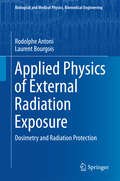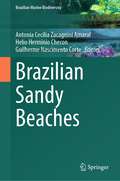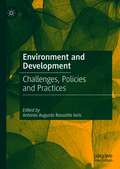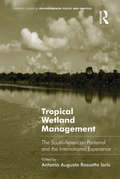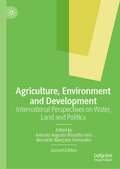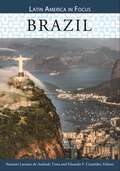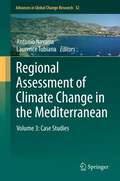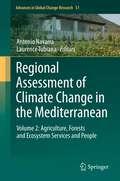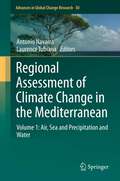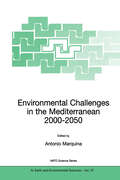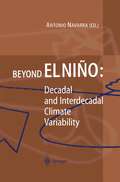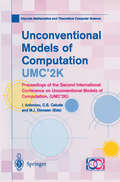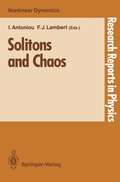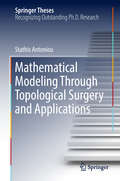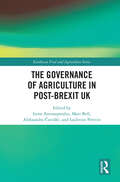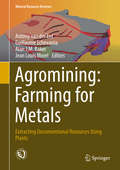- Table View
- List View
Geospatial Visualisation (Lecture Notes in Geoinformation and Cartography)
by Antoni Moore and Igor DreckiThis book is a selection of chapters evolved from papers on completed research submitted to GeoCart’2010 / the 1st ICA Regional Symposium on Cartography for Australasia and Oceania, held in Auckland, New Zealand, 1st -3rd September 2010. All of the chapters have been updated and revised thoroughly. They have been blind peer reviewed by two referees of international research standing in geospatial science, mostly in the subdisciplines of cartography and geovisualisation. The book features cutting edge topics such geovisual analytics, mobile / Web 2.0 mapping, spatiotemporal representation, cognitive cartography, historical mapping and 3D technology.
Applied Physics of External Radiation Exposure: Dosimetry and Radiation Protection (Biological and Medical Physics, Biomedical Engineering)
by Rodolphe Antoni Laurent BourgoisThis book describes the interaction of living matter with photons, neutrons, charged particles, electrons and ions. The authors are specialists in the field of radiation protection. The book synthesizes many years of experiments with external radiation exposure in the fields of dosimetry and radiation shielding in medical, industrial and research fields. It presents the basic physical concepts including dosimetry and offers a number of tools to be used by students, engineers and technicians to assess the radiological risk and the means to avoid them by calculating the appropriate shields. The theory of radiation interaction in matter is presented together with empirical formulas and abacus. Numerous numerical applications are treated to illustrate the different topics. The state of the art in radiation protection and dosimetry is presented in detail, especially in the field of simulation codes for external exposure to radiation, medical projects and advanced research. Moreover, important data spread in different up to date references are presented in this book. The book deals also with accelerators, X-rays facilities, sealed sources, dosimetry, Monte Carlo simulation and radiation regulation. Each chapter is split in two parts depending on the level of details the readers want to focus on. The first part, accessible to a large public, provides a lot of simple examples to help understanding the physics concepts under radiation external exposure. The second part, called “Additional Information” is not mandatory; it aims on explaining topics more deeply, often using mathematical formulations. The book treats fundamental radiometric and dosimetric quantities to describe the interaction in materials under the aspects of absorbed dose processes in tissues. Definitions and applications on limited and operational radiation protection quantities are given. An important aspect are practical engineering tools in industrial, medical and research domains. Source characterization and shielding design are addressed. Also more ”exotic” topics, such as ultra intense laser and new generation accelerators, are treated. The state of the art is presented to help the reader to work with the book in a self-consistent way. The basic knowledge necessary to apply Monte Carlo methods in the field of radiation protection and dosimetry for external radiation exposure is provided. Coverage of topics such as variance reduction, pseudo-random number generation and statistic estimators make the book useful even to experienced Monte Carlo practitioners. Solved problems help the reader to understand the Monte Carlo process. The book is meant to be used by researchers, engineers and medical physicist. It is also valuable to technicians and students.
Brazilian Sandy Beaches (Brazilian Marine Biodiversity)
by Antonia Cecilia Zacagnini Amaral Helio Herminio Checon Guilherme Nascimento CorteMore than 4000 beaches distributed along the Brazilian coastline are one of the country's main assets. They harbor endemic and diverse biota and provide numerous goods and services essential to human populations. However, they are under increasing pressure, trapped between the impacts of climate change and human activities in the terrestrial and marine environment, and the knowledge about their environmental characteristics and biodiversity is still insufficient to ensure their preservation. This book is the first-ever comprehensive work about Brazil's sandy beaches addressing their physical, ecological, and social aspects. It was written by an interdisciplinary group of leading Brazilian researchers from different regions of the country and also had the contribution of a few international experts. The information synthesized in this book is accessible to anyone who wants to know more about Brazilian coastal biodiversity and represents a significant step towards conserving Brazilian sandy beaches, their biodiversity, and ecosystem services.
Emergency Driven Innovation: Low Tech Buildings and Circular Design (Innovation, Technology, and Knowledge Management)
by Ernesto Antonini Andrea Boeri Francesca GiglioThis book explores the relationship between the circular economy and the building technologies within the quintuple helix innovation model. The main question the book answers is whether and how the conversion of sustainable construction processes can be a powerful engine of innovation for the industry. The post-disaster settlements and temporary shelters are assumed as examples of what can be defined as circular buildings in regards to the technical arrangements and features, material and process reversibility, as the social and participative dimensions.Several cases of these interventions are documented and classified by three thematic axes: design, building and living. This highlighted new trajectories for innovation in building technology, consistent with the social, economic and productive dynamics that no longer allows for growing performance by increasing the resource demand. A theoretic framework is traced supporting this vision, which shows how the low technologies can respond to the transition of the economic model from linear to circular. Within this trajectory, the low-tech design for remanufacturing represents a reference framework and a promising tool applicable to the building processes.The enabling technologies and new paradigms for the transition to circular economy emerging from the European research scenario are also mapped, outlining z`the possible future developments in line with open technical and societal challenges.
Environment and Development: Challenges, Policies and Practices
by Antonio Augusto Rossotto IorisThis book provides a comprehensive overview of emerging challenges facing different social groups, policy-makers and the international community related to economic growth, social development and environmental change, social inclusion and regional development. The book undertakes a critical assessment of the tensions associated with the failures of mainstream regulatory approaches and impacts of social and economic policies whilst widening the discussion on the interface between the expansion of the socio-environmental demands, equity and justice. These are crucial challenges, of great importance today and of equal relevance to the Global North and South. The book explores one of the main contradictions of development, the simplification of assessments and narrow consideration of alternatives. Taking this dilemma as its departure point, it goes on to examine the justification, trends and limitations of Western-based development and possible alternatives to fundamentally modify the basis and the rationale of the development process. It considers theoretical and lived experiences of development, paying attention to multiple scales, local realities and economic frontiers. Contributing authors explore policy recommendations and discuss effective practical tools for determining the values different people hold for ecosystem services and territorial resources. They cover the monitoring of change in the provision of ecosystem services that might increase the well-being of vulnerable groups as well as strategies to promote innovation and integrated, equitable and sustainable development.
Tropical Wetland Management: The South-American Pantanal and the International Experience
by Antonio Augusto Rossotto IorisRecent scientific development and politico-institutional experiences related to the conservation of the South-American Pantanal are explored in this book in relation to what is happening in other tropical wetland areas of international importance such as the Everglades in North America and the Okavango in Africa, as well as considering the European experience. An interdisciplinary group of authors examines the need to establish a constructive dialogue between scientists, policy-makers and local stakeholders and outline a future research agenda, including consideration of the impacts of climate change and the pressures of regional development, for wetland management.
Agriculture, Environment and Development: International Perspectives on Water, Land and Politics
by Antonio Augusto Rossotto Ioris Bernardo Mançano FernandesThe Second Edition of this book is completely revised and updated throughout providing an overview of current challenges faced within the area of Agri-food in relation to policymaking, ecological conservation and socio-environmental justice. Including a range of new chapters, the book explores some of the conceptual and analytical gaps that are presented by current approaches to this topic. The series of interconnected chapters offers a critical reinterpretation of the tensions associated with the failures of mainstream regulatory regimes, land and resource grabbing, and the impacts of global agri-food chains at local, regional and inter-sectoral scales. The book also examines past legacies and emerging challenges associated with agriculture modernisation, politico-spatial disputes, climate change, social movements, gender, ethnicity and education. It likewise addresses the transformative potential of different combinations of biophysical, socio-technical and socio-spatial practices of food sovereignty.
Humane Entrepreneurship and Innovation: An Alternative Way to Promote Sustainable Development (Emerald Studies in Sustainable Innovation Management)
by ANTONIO BOTTI AND ROBERTO PARENTEEntrepreneurship is evolving rapidly due to positive phenomena, such as digitalization and the green transition, and negative ones, such as crises and global emergencies. In this fresh approach to the unique role entrepreneurship can play across environmental protection and social equity, leading scholars explore the world of Humane Entrepreneurship (HumEnt). Introducing a new model of entrepreneurship that considers the human side of sustainable development, they delve into elements of Entrepreneurship Orientation, Human Resource Orientation, and Sustainability Orientation, focusing on risk-taking, effective people management practices, and societal expectations. Showing how HumEnt encourages employee engagement and promotes sustainability to leave positive impacts on society, the chapter authors examine how a human-centric approach to entrepreneurship can help achieve a balance between technological advancement and societal needs. Humane Entrepreneurship and Innovation provides a framework for entrepreneurs, students, and researchers to develop sustainable innovations that benefit society as a whole. This inclusive approach encourages entrepreneurs to consider the needs of all stakeholders, including employees, customers, and the environment. The Emerald Studies in Sustainable Innovation Management series aims to explore innovation management's advancements in turbulent times, with special attention to the transition towards a sustainable economy.
Brazil (Latin America in Focus)
by Antonio Luciano de Andrade Tosta Eduardo F. CoutinhoIdeal for high school and undergraduate students, this one-stop reference explores everything that makes up modern Brazil, including its geography, politics, pop culture, social media, daily life, and much more.Home to the 2014 FIFA World Cup and the 2016 Summer Olympic Games—and one of the world's fastest-growing economies—Brazil is quickly becoming a prominent player on the international stage. This book captures the essence of the nation and its people in a unique, topically organized volume. Narrative chapters written by expert contributors examine geography, history, government and politics, economics, society, culture, and contemporary issues, making Brazil an ideal one-stop reference for high school and undergraduate students.Coverage on religion, ethnicity, marriage and sexuality, education, literature and drama, art and architecture, music and dance, food, leisure and sport, and media provides a comprehensive look at this giant South American country—the largest nation in Latin America as well as the fifth largest nation in the world. Students will be engaged by up-to-the-minute coverage of topics such as daily life, social media, and pop culture in Brazil. Sidebars and photos highlight interesting facts and people, while a glossary, a chart of holidays, and an annotated bibliography round out the work.
Regional Assessment of Climate Change in the Mediterranean: Volume 3: Case Studies (Advances in Global Change Research #52)
by Antonio Navarra and Laurence TubianaThis is the third volume of a three-volume final report, which thoroughly describes, synthesizes and analyzes the results of the four-year Integrated Research Project CIRCE – Climate Change and Impact Research: Mediterranean Environment, funded by the EU 6th Framework Programme. Conducted under the auspices of the National Institute of Geophysics and Volcanology in Rome, Italy, the study was designed to predict and to quantify the physical impacts of climate change in the Mediterranean, and to assess the most influential consequences for the population of the region.
Regional Assessment of Climate Change in the Mediterranean: Volume 2: Agriculture, Forests and Ecosystem Services and People (Advances in Global Change Research #51)
by Antonio Navarra and Laurence TubianaVolume 2 of a three-volume final report thoroughly describes, synthesizes and analyzes the results of the four-year Integrated Research Project CIRCE – Climate Change and Impact Research: Mediterranean Environment, funded by the EU 6th Framework Programme. Conducted under the auspices of the National Institute of Geophysics and Volcanology in Rome, Italy, CIRCE was designed to predict and to quantify the physical impacts of climate change in the Mediterranean, and to assess the most influential consequences for the region’s population. This volume incorporates Parts 3 and 4 of the report, reviewing current knowledge of observed climate variability and trends in the Mediterranean, and including descriptions of available temperature and precipitation station and gridded data sets.
Regional Assessment of Climate Change in the Mediterranean: Volume 1: Air, Sea and Precipitation and Water (Advances in Global Change Research #50)
by Antonio Navarra and Laurence TubianaVolume 1 of a three-volume final report describes, synthesizes and analyzes the results of the four-year Integrated Research Project CIRCE – Climate Change and Impact Research: Mediterranean Environment, funded by the EU 6th Framework Programme. Conducted under the auspices of the National Institute of Geophysics and Volcanology in Rome, Italy, CIRCE was designed to predict and to quantify the physical impacts of climate change in the Mediterranean, and to assess the most influential consequences for the region’s population. This volume incorporates the first two parts of the report, reviewing current knowledge of observed climate variability and trends in the Mediterranean, and including descriptions of available temperature and precipitation station and gridded data sets.
Physical Oceanography of the Adriatic Sea: Past, Present and Future
by AntonioArtegiani Pierre-MariePoulain MiroslavGačić BenoitCushman-RoisinBecause of its centrallocation in the Old World, the Adriatic Sea has long been explored and studied. Modern methods of investigation, however, have accelerated the pace of study during the last decade. These are the ADCP currentmeter, satellite imagery, drifter technology, and, last but not least, the computer with its arsenal of tools for data analysis and model simulations. As a result of this renaissance, the Adriatic Sea and its sub-basins are currently the object of intensified scrutiny by a number of scientific teams, in Europe and be yond. Questions concerning the mesoscale variability that dominates regional motions, the seasonal circulation of the sea, and its long-term climatic role in the broader Mediterranean, have become topics of lively discussions. The time was ripe then when an international workshop dedicated to the physical oceanography of the Adriatic Sea was convened in Trieste on 21-25 September 1998. Its objectives were to assess the current knowledge of the oceanography of the Adriatic Sea, to review the newly acquired observations, to create syn ergy between model simulations and observations, and to identify directions for future Adriatic oceanography. This book, however,is not the mere proceedings of the workshop. It was written as a monograph synthetizing the current knowledge of the physical oceanography of the Adriatic Sea, with the hope that it will serve as a reference to anyone interested in the Adriatic. The book also identifies topics in need of additional inquiry and proposes research directions for the next decade.
Environmental Challenges in the Mediterranean 2000–2050: Proceedings of the NATO Advanced Research Workshop on Environmental Challenges in the Mediterranean 2000–2050 Madrid, Spain 2–5 October 2002 (NATO Science Series: IV: #37)
by AntonioMarquinaThis book addresses six key factors that will affect environmental policies in the Mediterranean region during the next fifty years: population growth, climate change, soil erosion and desertification, water scarcity, food production, and urbanization and pollution. The authors assess these as potential sources of violent conflict. The interdisciplinary approach makes this a relevant and useful reference for a broad range of professionals, specialists and researchers.
Beyond El Niño: Decadal and Interdecadal Climate Variability
by AntonioNavarraThe interest and level of research into climate variability has risen dramatically in recent years, and major breakthroughs have been achieved in the understanding and modelling of seasonal to interannual climate variability and prediction. At the same time, the documentation of longer term variability and its underlying mecha nisms have progressed considerably. Within the European Commission's Environment and Climate research programs several important projects have been supported in these areas - including the "Dec adal and Interdecadal Climate variability Experiment" (DICE) which forms the basis of this book. Within the EC supported climate research, we see an increasing importance of research into climate variability, as is evidenced in the upcoming Fifth Framework Programme's Key Action on Global Change, Climate and Biodi versity. This is because of the obvious potential socio-economic benefits from sea sonal to decadal scale climate prediction and equally important for the fundamental understanding of the climate system to help improve the quality and reliability of future climate change and mankind's current interference with it. The DICE group has performed important and pioneering work, and we hope this book will receive the wide distribution and recognition it deserves. We wel come the contributions from distinguished researchers from US, Japan and Canada to the EC's DICE group towards completing the scope of the book and as an exam ple of international cooperation which is essential in such a high-level scientific endeavor.
Unconventional Models of Computation, UMC’2K: Proceedings of the Second International Conference on Unconventional Models of Computation, (UMC’2K) (Discrete Mathematics and Theoretical Computer Science)
by I. Antoniou C. S. Calude M. J. DinneenSolitons and Chaos (Research Reports in Physics)
by Ioannis Antoniou Franklin J. Lambert"Solitons and Chaos" is a response to the growing interest in systems exhibiting these two complementary manifestations of nonlinearity. The papers cover a wide range of topics but share common mathematical notions and investigation techniques. An introductory note on eight concepts of integrability has been added as a guide for the uninitiated reader. Both specialists and graduate students will find this update on the state ofthe art useful. Key points: chaos vs. integrability; solitons: theory and applications; dissipative systems; Hamiltonian systems; maps and cascades; direct vs. inverse methods; higher dimensions; Lie groups, Painleve analysis, numerical algorithms; pertubation methods.
Mathematical Modeling Through Topological Surgery and Applications (Springer Theses)
by Stathis AntoniouTopological surgery is a mathematical technique used for creating new manifolds out of known ones. In this book the authors observe that it also occurs in natural phenomena of all scales: 1-dimensional surgery happens during DNA recombination and when cosmic magnetic lines reconnect; 2-dimensional surgery happens during tornado formation and cell mitosis; and they conjecture that 3-dimensional surgery happens during the formation of black holes from cosmic strings, offering an explanation for the existence of a black hole’s singularity. Inspired by such phenomena, the authors present a new topological model that extends the formal definition to a continuous process caused by local forces. Lastly, they describe an intrinsic connection between topological surgery and a chaotic dynamical system exhibiting a “hole drilling” behavior. The authors’ model indicates where to look for the forces causing surgery and what deformations should be observed in the local submanifolds involved. These predictions are significant for the study of phenomena exhibiting surgery and they also open new research directions. This novel study enables readers to gain a better understanding of the topology and dynamics of various natural phenomena, as well as topological surgery itself and serves as a basis for many more insightful observations and new physical implications.
The Governance of Agriculture in Post-Brexit UK (Earthscan Food and Agriculture)
by Irene Antonopoulos Matt Bell Aleksandra 268 Avoski Ludivine PetetinThis book provides a multidisciplinary analysis of the impact of Brexit on British agriculture and associated areas, discussing the Common Agricultural Policy and the Agriculture Act 2020. The Brexit referendum provoked new debates and questions over the future of agriculture in Britain and the potential positive and negative impacts of Brexit on both farmers and consumers. These debates, as well as the ensuing proposals relevant to the Agriculture Act 2020, have exposed the multidimensional effects of Brexit when it comes to agriculture. With a focus on profitability, the rights of farmers, environmental protection, as well as animal welfare, this book brings together an interdisciplinary analysis of the future of British agriculture in post-Brexit Britain. More specifically, it addresses the criticisms over the Common Agriculture Policy, presents an analysis of the Agriculture Act 2020, and considers suggestions for future developments. Through this analysis, the book suggests a way towards the future, with a positive outlook towards a competitive and sustainable agriculture that will satisfy the needs of farmers and consumers while ensuring environmental protection, animal welfare, and rural development. This book will be of great interest to students and scholars of food and agricultural policy and politics, agroecology and rural development, as well as policymakers involved in Britain’s post-Brexit environmental policy.
The Governance of Agriculture in Post-Brexit UK (Earthscan Food and Agriculture)
by Irene Antonopoulos Matt Bell Aleksandra Čavoški Ludivine PetetinThis book provides a multidisciplinary analysis of the impact of Brexit on British agriculture and associated areas, discussing the Common Agricultural Policy and the Agriculture Act 2020. The Brexit referendum provoked new debates and questions over the future of agriculture in Britain and the potential positive and negative impacts of Brexit on both farmers and consumers. These debates, as well as the ensuing proposals relevant to the Agriculture Act 2020, have exposed the multidimensional effects of Brexit when it comes to agriculture. With a focus on profitability, the rights of farmers, environmental protection, as well as animal welfare, this book brings together an interdisciplinary analysis of the future of British agriculture in post-Brexit Britain. More specifically, it addresses the criticisms over the Common Agriculture Policy, presents an analysis of the Agriculture Act 2020, and considers suggestions for future developments. Through this analysis, the book suggests a way towards the future, with a positive outlook towards a competitive and sustainable agriculture that will satisfy the needs of farmers and consumers while ensuring environmental protection, animal welfare, and rural development. This book will be of great interest to students and scholars of food and agricultural policy and politics, agroecology and rural development, as well as policymakers involved in Britain’s post-Brexit environmental policy.
Electronic Structure and Magneto-Optical Properties of Solids: (pdf)
by Victor Antonov Bruce Harmon Alexander YareskoAgromining: Extracting Unconventional Resources Using Plants (Mineral Resource Reviews)
by Antony van der Ent Guillaume Echevarria Alan J.M. Baker Jean Louis MorelThis is the first book on global agromining/phytomining technology. It presents the complete metal farming or agromining chain; an emerging technology expected to be transformative in the extraction of resources of those elements not accessible by traditional mining techniques. Meeting the demand for critical minerals (rare earth elements, platinum group elements, nickel cobalt) is increasingly difficult in the 21st century due to resource depletion and geopolitical factors. Agromining uses hyperaccumulator plants as “metal crops” farmed on sub-economic soils or mineral waste to obtain valuable elements.This book, which follows the metal farming chain, starts with the latest information on the global distribution and ecology of hyperaccumulator plants, biogeochemical pathways, the influence of rhizosphere microbes, as well as aspects of propagation and conservation of these unusual plants. It then presents the state of the art in new tools for identifying hyperaccumulator plants and for understanding their physiology and molecular biology. It goes on to describe the agronomy of “metal crops,” and opportunities for incorporating agromining into rehabilitation and mine closure, including test-cases of nickel, cobalt, selenium, thallium, rare earth elements and PGEs. Finally, it concludes with an overview of the latest developments in the processing of bio-ores and associated products. This book is edited and authored by the pioneers in the field who have been at the foreground of the development of agromining over the past three decades. It is timely as agromining is now at a pivotal point in its development with rapid expansion of activities in the field around the globe. As such it is of interest to environmental professionals in the minerals industry, government regulators and academics.
Introductory Physics: Summaries, Examples, and Practice Problems
by Michael AntoshPhysics describes how motion works in everyday life. Clothes washers and rolling pins are undergoing rotational motion. A flying bird uses forces. Tossing a set of keys involves equations that describe motion (kinematics). Two people bumping into each other while cooking in a kitchen involves linear momentum. This textbook covers topics related to units, kinematics, forces, energy, momentum, circular and rotational motion, Newton’s general equation for gravity, and simple harmonic motion (things that go back and forth). A math review is also included, with a focus on algebra and trigonometry. The goal of this textbook is to present a clear introduction to these topics, in small pieces, with examples that readers can relate to. Each topic comes with a short summary, a fully solved example, and practice problems. Full solutions are included for over 400 problems. This book is a very useful study guide for students in introductory physics courses, including high school and college students in an algebra-based introductory physics course and even students in an introductory calculus-level course. It can also be used as a standalone textbook in courses where derivations are not emphasized.
Introductory Physics: Summaries, Examples, and Practice Problems
by Michael AntoshPhysics describes how motion works in everyday life. Clothes washers and rolling pins are undergoing rotational motion. A flying bird uses forces. Tossing a set of keys involves equations that describe motion (kinematics). Two people bumping into each other while cooking in a kitchen involves linear momentum. This textbook covers topics related to units, kinematics, forces, energy, momentum, circular and rotational motion, Newton’s general equation for gravity, and simple harmonic motion (things that go back and forth). A math review is also included, with a focus on algebra and trigonometry. The goal of this textbook is to present a clear introduction to these topics, in small pieces, with examples that readers can relate to. Each topic comes with a short summary, a fully solved example, and practice problems. Full solutions are included for over 400 problems. This book is a very useful study guide for students in introductory physics courses, including high school and college students in an algebra-based introductory physics course and even students in an introductory calculus-level course. It can also be used as a standalone textbook in courses where derivations are not emphasized.
Characterization of an Upper Permian Tight Gas Reservoir: A Multidisciplinary, Multiscale Analysis from the Rotliegend, Northern Germany (Springer Theses)
by Philipp Antrett"The thesis of Philipp Antrett is focused on reservoir properties, petrography, lithofacies and sedimentology, core analysis and nanoporosity studies. It will be of major interest for colleagues involved in the exploration and production of tight gas reservoirs in Northern Europe and elsewhere." - François Roure, August 2012 This thesis describes a multidisciplinary, multiscale approach to the analysis of tight gas reservoirs. It focused initially on the facies architecture of a Permian tight gas field in the Southern Permian Basin (SPB), East Frisia, northern Germany. To improve field development, 3D seismic data, wireline and core data were compared to a reservoir analogue in the Panamint Valley, California, United States. In addition to the large scale approach, a work flow that investigates microporosity by combining Scanning Electron Microscopy-Broad Ion Beam (SEM-BIB) and optical microscopy was developed. For a better understanding of the depositional environment and reservoir rock distribution in the SPB, a sedimentary facies analysis of four cores from the tight gas field in East Frisia was compared to a second study area in northern central Germany. This study demonstrates that tight gas exploration and production requires multidisciplinary, multiscale approaches beyond standard seismic interpretation work flows to better understand the temporal and spatial evolution of these complex reservoirs.

